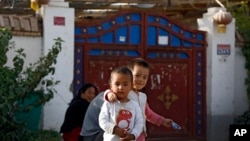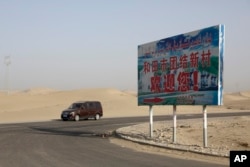The first week of February is marked by grief for Zubayra Shamseden not only because she lost loved ones nearly three decades ago, she says, but because China’s repressive policies toward Uyghurs continue.
"I have been commemorating this day and protesting for the past 28 years, every Feb. 5," Shamseden told VOA. "The Ghulja massacre in 1997 was the beginning of today’s ongoing genocide of Uyghurs."
Many protesters were killed by the Chinese armed forces that day in what Shamseden describes as a violent Chinese government crackdown on a peaceful Uyghur protest in Ghulja, a city in China’s northwestern region of Xinjiang. During subsequent crackdowns, she also lost her brother, Sadirdin, and her nephew, Hemmat Muhammet.
In the aftermath, another brother was sentenced to life in prison.
"The Chinese government should release all prisoners, including my brother, who were unjustly imprisoned," she told VOA.
Outset of violence
In recent years, China’s policy toward Uyghurs in Xinjiang has drawn global attention, with the U.S. officially labeling China’s actions as genocide. The United Nations has raised alarms, warning that China’s conduct may constitute crimes against humanity, including mass detentions, forced labor and other abuses. Beijing, which refers to the 1997 crackdown as "the Yining incident" — a measured police response to an unfolding "riot" — has dismissed these claims as "sheer falsehoods" driven by U.S.-led anti-China forces.
Now Chinese outreach coordinator for the Washington-based Uyghur Human Rights Project, Shamseden led a demonstration Wednesday outside the Chinese Embassy in Washington. Joined by a dozen activists, she marked the anniversary of what she and many others refer to as the Ghulja Massacre.
Recalling the violence of that day, Shamseden said a few hundred unarmed Uyghur youths marched through Ghulja, calling for basic rights.
"They took to the streets peacefully and unarmed, asking the government to respect their Islamic religious freedom and Uyghur cultural practices," said Shamseden, a former vice president of the World Uyghur Congress.
The youths also called for the release of previously "arrested leaders of their gatherings, because the Chinese authorities didn’t allow them to gather for Meshrep," she said.
Meshrep, a traditional Uyghur community gathering, has been recognized by UNESCO as part of Uyghur intangible cultural heritage since 2010.
Some Meshrep organizers, Shamseden said, had previously been arrested despite initial government approval to hold Meshrep gatherings.
Speaking out about a drug crisis among fellow youths in the region had been the purpose of their gatherings.
"The Uyghur youth in Ghulja sought to address the growing heroin addiction crisis that spread in the early 1990s," Shamseden said. "They turned to Meshrep — traditional gatherings that included sports, music, performances, and other forms of entertainment — to help young Uyghurs struggling with addiction and alcohol."
Officials in Beijing, however, soon deemed the gatherings a threat. In August 1995, key organizers were arrested, prompting protests in Ghulja. Authorities responded by banning Meshrep and cracking down on other Uyghur-led initiatives.
Uyghurs were later barred from holding events of any kind.
Different perspective
Liu Pengyu, spokesperson for the Chinese Embassy in Washington, described the protest as "not a so-called massacre, but a serious incident of beating, smashing, and looting" carried out by a burgeoning terrorist group.
"Xinjiang was once a major area where extremist groups infiltrated and carried out violent terrorist activities," Liu said, adding that China’s measures in the region have been aimed at countering terror-based insurgency within the framework of Chinese law.
A 1997 Human Rights Watch report, however, linked the crackdown to a secret Chinese government directive known as "Document No. 7." Issued in March 1996 by the Politburo Standing Committee of the Chinese Communist Party, the document laid out measures to strengthen control over Xinjiang, including restrictions on religious and cultural activities, increased military presence and tighter security enforcement.
The Washington-based Campaign for Uyghurs described the Chinese government crackdown on protesters as a massacre, stating that the policies behind that bloodshed have evolved into the genocide unfolding today.
The Ghulja Massacre was "a pivotal moment when the world had an opportunity to recognize China’s trajectory towards mass atrocities — and failed to act," said Rushan Abbas, the group's executive director, in a statement issued Wednesday.
"That failure emboldened the [Chinese Communist Party]," said Abbas, who is also chairperson of the executive committee at World Uyghur Congress. "Today, as Uyghurs endure genocide, history repeats itself. The price of inaction is paid in human lives, and every day without accountability reinforces the Chinese regime’s belief that it can commit atrocities without consequence."
According to Shamseden, who had been in Australia since 1993, visiting Ghulja only in the aftermath of the crackdown in 1998, mass arrests and collective punishment had by then become routine.
This crackdown led to the arrest, torture and release of her sister for allegedly helping a Ghulja protester, the killing of her brother Sadirdin in Kazakhstan under mysterious circumstances, and the killing of her nephew Hemmat Muhammet by Chinese police in Ghulja. Shamseden’s nephew and brother were leading members of earlier Meshrep gatherings.
In 1999, Shamseden said another younger brother, Abdurazzak was sentenced by the Chinese officials for being a separatist, receiving a sentence of life in prison.
To this day, she said, she has been unable to learn any details about her brother’s current fate, including whether he is alive.
According to the U.S. Commission on International Religious Freedom, Abdurazzak’s sentence was commuted by the Xinjiang Uyghur Autonomous Region High People's Court in August 2016. He had reportedly been serving time at Urumqi No.1 Prison, and is expected to be released in 2036, but his exact whereabouts remain unknown.










